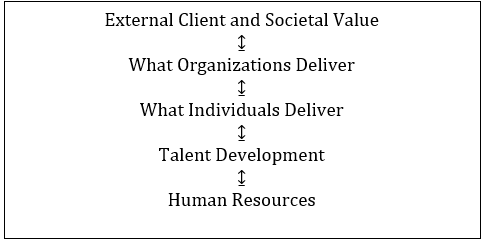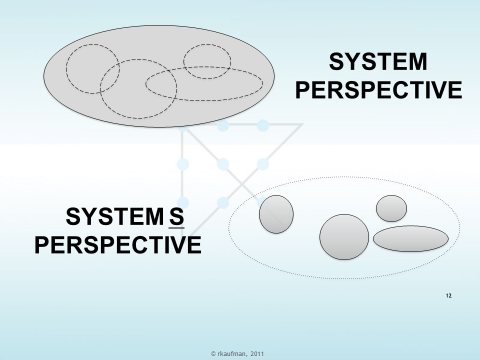ATD Blog
Talent Development and the Future for Organizations: Part One
Thu Jun 29 2017

To pass their value upward, what should competent and dedicated talent development leaders do and accomplish?
A strategic plan will illuminate the answers to these questions. A strategic plan can help leaders align resources, people, and what the organization provides in a manner that creates the most value for everyone, including stakeholders and employees. This, in turn, can illustrate and justify the role of talent development in creating value.
Many talent development efforts focus primarily on individuals and their performance at their jobs. But it’s important to make sure that each person in the organization contributes uniquely to the bigger picture of what the organization uses, does, produces, and delivers, and the value added outside of the organization. This distinction can be illustrated by the systems versus system perspectives. The systems perspective only considers parts of the whole system, and not their context or connectivity. The system perspective considers the entire organization, including what your company offers to society in general.(See Figure 2.) A useful plan will provide the criteria for planning for the entire system.
**


Talent development is a vital element for any organization that expects to survive and thrive. We must determine what talent should deliver and why it should deliver it to add measurable value to all internal and external stakeholders; our assessment must include the entire context of talent development. There are a few basic concepts and steps to make sure that talent development will be successful by adding measurable value to ensure the future growth and prosperity of any organization.
Building From Talent Development to Organizational Success
Human talent is the basic building block for everything an organization uses, does, produces, and delivers, and these things, in turn, create the value the company offers to all stakeholders. Figure 1 shows how talent development fits into the value chain.
Figure 1. Talent Development Alignment
Finally, a good strategic plan should provide valid data to justify what talent development uses, does, produces, and delivers, throughout the entire system. There are several guiding principles of strategic planning that talent development professionals must keep in mind:
Measurable results are good.
Useful measurable results are even better.
Talent must deliver useful results that add value within and outside the organization.
Strategic planning is about ends (results and consequences), not just about means (programs, activities, courses, or delivery).
Strategic planning requires that criteria are based on evidence.
All organizations are means to societal ends. If they are not adding measurable value to our shared world, they are likely subtracting value.
All organizations must demonstrate value for money to all their stakeholders.
There are three levels of results for every organization: external contributions, organizational contributions, and individual contributions. These define the context for talent development.
All three levels of results must be aligned for efficient operations so people know what to do and deliver, and why it is important to do so.
Performance data from each of these three levels may be derived by documenting the gaps (needs) between current results and contributions and desired results and contributions.
It is vital that all parts of any organization operate successfully individually as well as together to add value to all internal and external stakeholders. The function of a practical strategic plan is to ensure that this alignment takes place.
A useful method for obtaining these data is called needs assessment, in which needs are gaps in results, not gaps in means or resources.
Collecting Valid Data to Assure That Talent Development Will Contribute to Organizational Success
Talent development, regardless of the delivery methods used, should be based on what the organization must deliver. What should be delivered is best based on the needs identified for all stakeholders. Therefore, it is recommended that we identify, in measurable performance terms, the needs between current results and consequences and desired results and consequences—the gaps between what is and what should be.
The needs at the three aligned levels of results will identify and justify what the organization should use, do, produce, and deliver. This is different from other approaches that focus on wants—people’s perceptions of the ways and means to close gaps. The needs approach first analyzes the gaps themselves, so appropriate means may be selected to close them.
Identifying What the Organization Wants to Become, and How It Justifies Its Funding and Existence
A useful strategic plan identifies and justifies what an organization wants to become. What an organization does and delivers will be based on the value it provides to all stakeholders, and the funding and support for an organization will be based on the same criteria. To gain the insight required to create a strategic plan, we must observe the needs—gaps in results—between where we are and where we want to be, and prioritize those needs based on the costs to meet the needs as compared with the costs to ignore them.
A worthy strategic plan provides the measurable objectives for creating our future and thus provides the criteria for defining how to get from here to there, the criteria for implementing the plan, and the criteria for evaluation and continual improvement. This approach provides the North Star by which to navigate organizational decision making. It also helps us understand how the larger community of the world outside our organizations is the largest stakeholder of all, a concept that will be explored in greater detail in part two of this blog series.
**
You've Reached ATD Member-only Content
Become an ATD member to continue
Already a member?Sign In
